Without the right kind of finish, wood can become very dry and lifeless very fast. Wood needs to be coated with a clear finish in order to give it richness and depth and more than that, protect it from the weather, knocks and scrapes.
See Also:
Here is a guide on spraying polyurethane.?
More...
Below is a guide on how to use polyurethane, the toughest clear finish, to bring out the beauty of your furniture.
The Ultimate Guide to
Polyurethane Paint Finishes and
How To Spray Efficiently
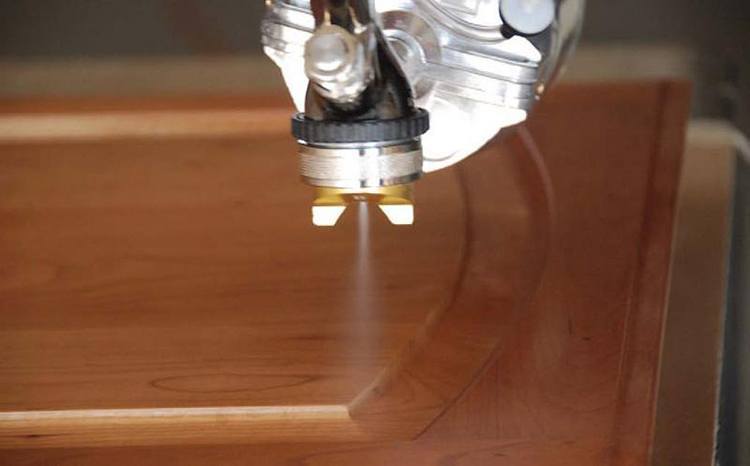
HVLP Spray via CANADIAN Woodworking & HOME IMPROVEMENT
What Is Polyurethane?
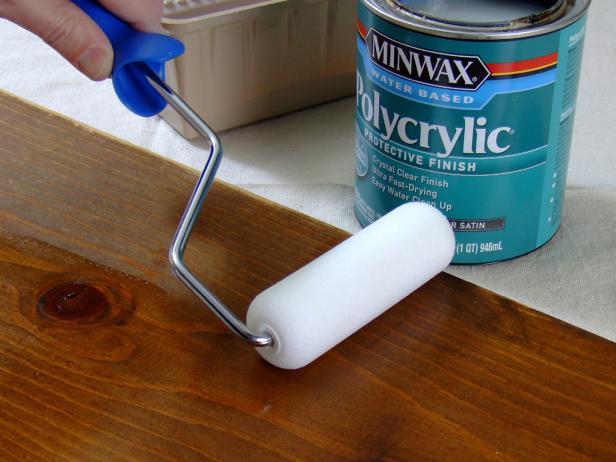
Mini roller is painting table with Polyurethane via diy network
To begin with, you need to understand what you are getting yourself into. Polyurethane is an extremely tough vanish but the result means that it is a lot more resistant to solvents, water, abrasion and other impacts compared to other wood finishes.
Some polyurethane spray paints are made with oils that give wood a warm, amber tone while others are water based and give wood a light color.
Oil, Water and Combined Which One Is Best?
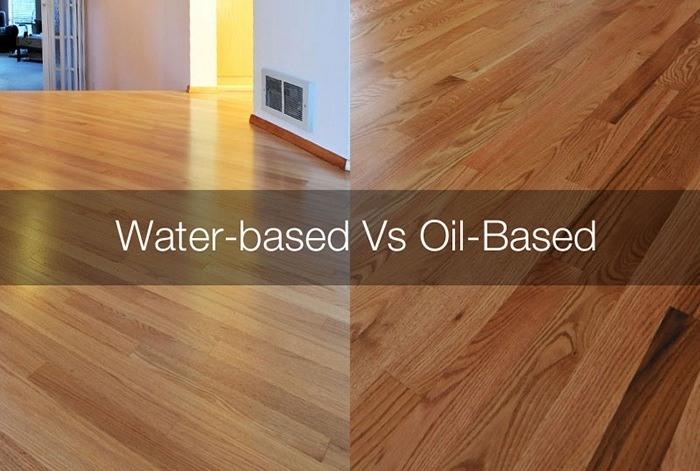
Oil-base Polyurethane versus Water-base Polyurethane via GO GREEN FLOORS
All types have different characteristics so you can choose the one you prefer.
- Oils based polys turn a little amber when used on wood and it forms a hard and durable coat in just a few coats. It dries slower than water-based poly and cleans up with mineral spirits.
- Water-based polys are white in the can but look crystal clear when dry. If you want to preserve the color of the wood then this is a good choice. More coats are needed for this type, it dries a lot quicker and cleans up with water and soap. Do not use ammonia based cleaners on it.
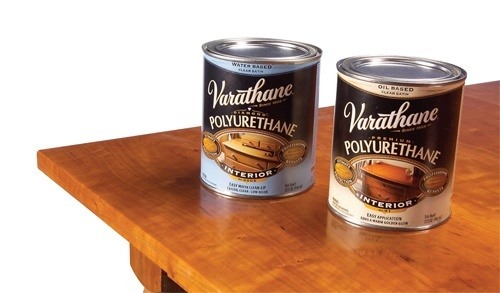
Water-Based vs. Oil-Based Polyurethane via POPULAR Woodworking MAGAZINE
- Combined water-based and oil-modified will look cloudy but will dry like the oil-based poly. It dries very fast, is compatible with every wood and cleans up with water.
Choosing A Polyurethane Product
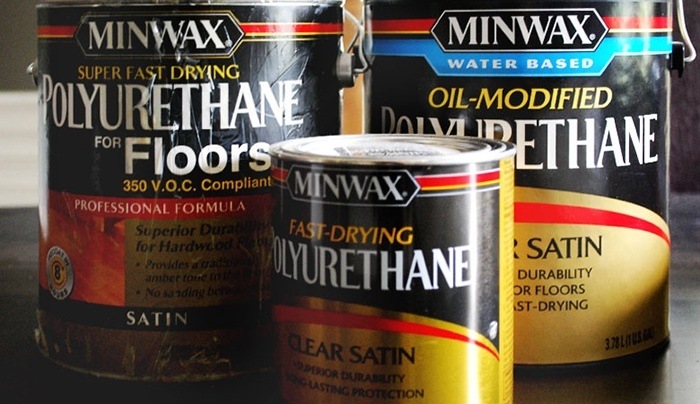
Protective Wood Finishes via Bauen
Polys are available in gloss, semi gloss or satin finishes. While a glossy finish gives a shiny look, a semi-gloss gives a muted appearance while satin gives a matte appearance.
You can go with what you like but keep in mind that the glossier you make the finish, the more any underlying imperfections or future wear and tear will show.?
Interior or Exterior
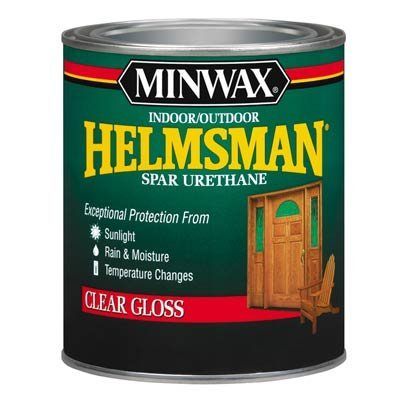
Exterior: Spar Urethane via This Old House
When picking a polyurethane paint, you have to understand that there are interior and exterior paints. You can use exterior poly paints indoor but you cannot use interior poly paints outdoor because they don’t have the additives to help protect the finish from UV rays.?
Setting Up The Work Area
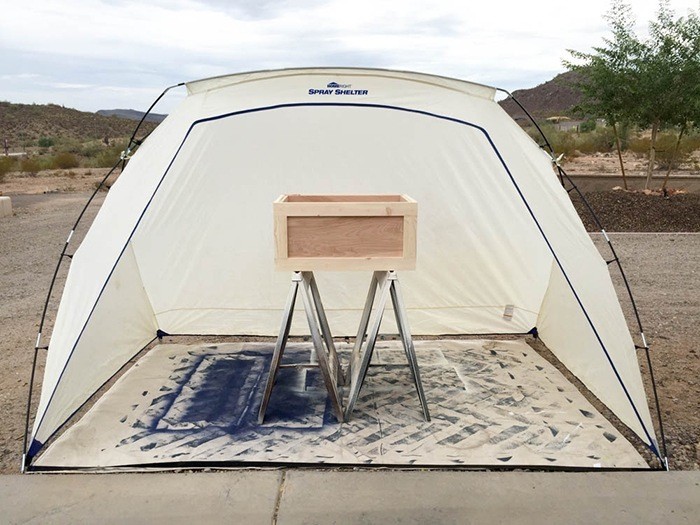
HomeRight Spray Shelter via Addicted 2 DIY
First of all, you need to understand that poly paints have VOC and you need to work in a well ventilated area for your safety. You can also use a ventilation fan for your spraying project.
You can cover whatever is close with newspapers or drop cloths in order to protect them from the spray or alternatively, you can use the projector in a large box so as to control how far the paint goes.?
What You Need To Know About Spraying Poly Paint
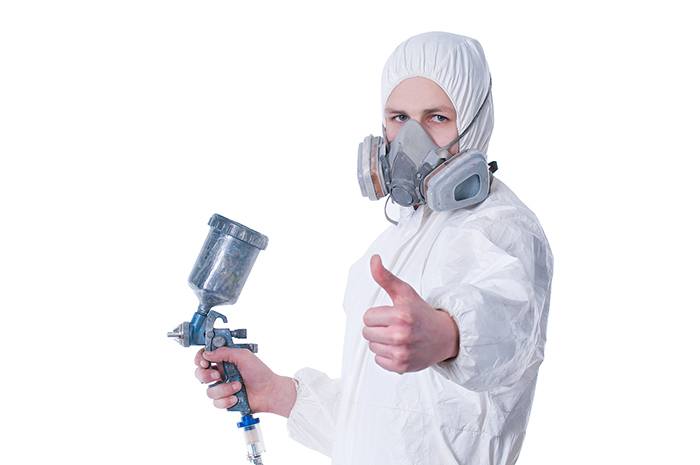
Health and Safety via GO PAINT SPRAYER
Since you understand the danger of poly paints, you need to protect yourself with the right protective gear while spraying polyurethane paints.
The liquid paint that comes out of the spray gun is known as aerosol and when inhaled into the lungs, one can have very serious health issues.
Breathing aerosol can cause irritation in the nose, throat and lungs and the symptoms are usually coughing, dry throat, wheezing or tight chest. Eye contact with aerosol causes irritations as so does skin contact.
You should wear a protective mask or a respirator depending on the type of the paint, a protective apron over your clothes and wear disposable gloves to keep the paint off your hands.?
The Kind Of Paint Sprayer You Will Need
First of all, if you are a beginner or this is your fist time, you might need to practice spraying with some cardboard before you get to the important wood.
HVLP Spray Guns
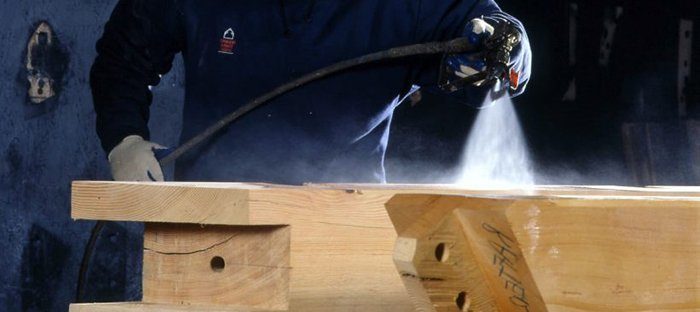
HVLP spray guns via Pittsburgh Spray Equipment
A HVLP paint sprayer is what you want to use when spraying polyurethane because it if by far the safest and the most efficient. When you use conventional paint sprayers, you will end up with one-third of the finish on your wood and the rest in the air.
On the other hand, with A HVLP, you will have two-thirds on the paint while the rest in the atmosphere. This is good for some reasons. To begin with, it will be good for the environment and second, it will save you a lot of paint.
The other reason why a HVLP paint sprayer is the best paint sprayer is because a spray gun atomizes a finish, meaning that it breaks it to a mist.
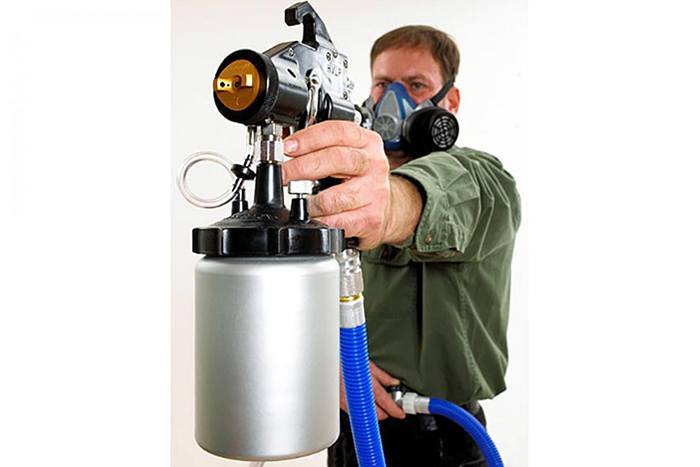
HVLP opener via WOOD Magazine
With the right balance of air pressure, coating viscosity, speed of application and distance of the sprayer from the surface, the mist will leave a smooth even coating that will not only protect the wood but look beautiful as well.?
When using an unconventional spray, chances are you will waste a lot of paint and risk blowback (where the paint hits the surface and bounces back leaving an uneven surface).
This will not happen with HVLP, which actually means high volume and low pressure.?
Electric Airless Spray Guns
?You can use an electric paint sprayer as they are compact, hand held and self contained. You won’t have to deal with turbines, hose or compressors.
An airless paint sprayer, as the name suggest does not use air at all unlike the conventional guns and instead of mixing the paint with air, it force the paint out with so much pressure that it atomizes as it leaves the gun.
Some of these guns came with batteries and you won’t need to use a power cord.
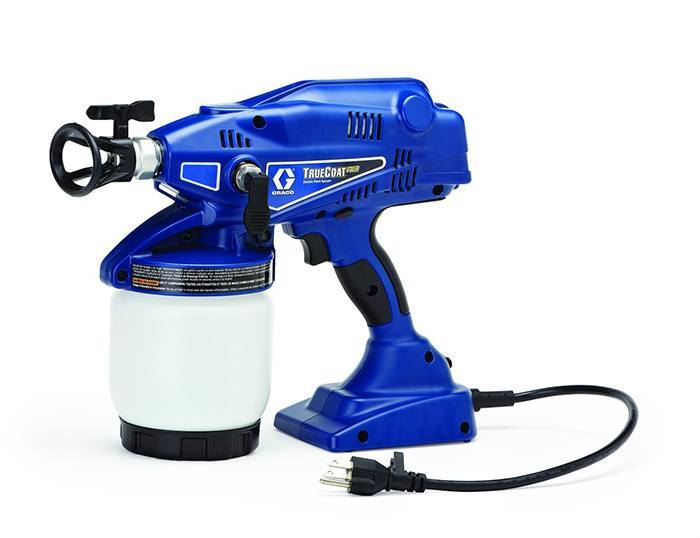
TrueCoat Handheld Electric Airless Sprayer via Graco
Upside of using airless guns?
The best thing about the airless guns is their versatility. They can spray the polyurethane finish just as well as anything else you need to paint without even having to thin it.
With this type of gun, you will have almost no paint in the air and you will be done before you know it.
Downside?
On the other side, while using electric guns, you need to have a lot of experience because something moving that fast can be hard to control and cause a lot of damages and more so if you are applying a thin coat.
If you still want to use it, practicing will benefit you for the start.?
The other drawback is the weight you will be carrying. Even though you reduce the amount of time you will spend spraying, you will be carrying around a pump and a cup of finish, which can be quite heavy.
However, some of them also come with the flexibility of removing the cup and attaching a hose directly to the paint.?
How To Spray Polyurethane
The Right Temperature
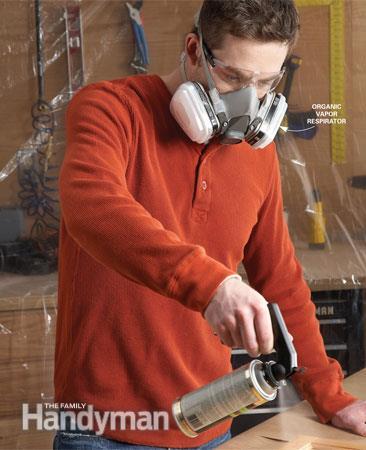
Get set up for spraying via THE FAMILY HANDYMAN
Make sure you do not spray in hot weather or in a windy area because it will dry too fast. You need to make sure the temperature is right depending on your paint type so you can have a smooth finish.
To Get A Spatter Free Coverage
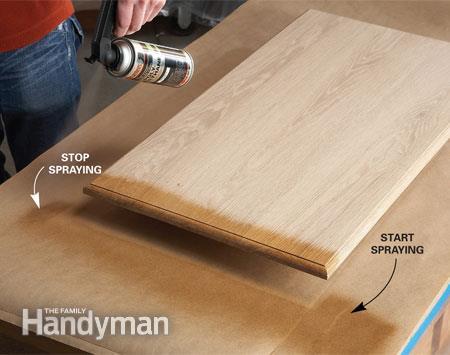
Start the spray off the edge via THE FAMILY HANDYMAN
It will be hard to get an even coverage if you start and stop the gun on your wood. There are sputters that happen as soon as you start spraying and the finish will build up unless you move fast enough.
To avoid sputters, start spraying outside the wood, move across it at a very even pace, and then stop the gun just outside of it.
Don’t Spray In An Arc
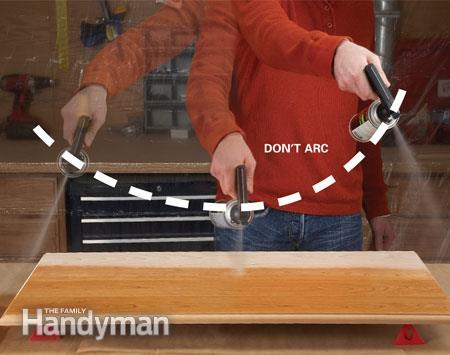
Don't swing the can in an arc via THE FAMILY HANDYMAN
It might feel natural to do this but the finish will buildup in the middle and it will result to uneven coverage.
Overlap The Spray Halfway
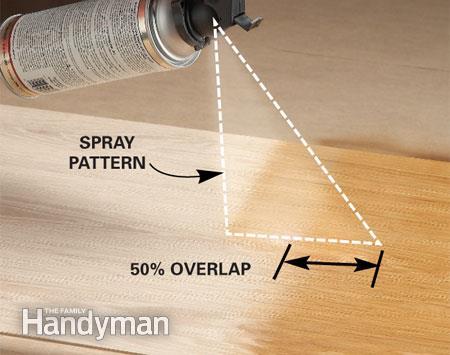
Overlap the spray via THE FAMILY HANDYMAN
You should overlap the spray about halfway of the last sprayed section. Spraying right at the edges will leave a band of thick finish where the strips meet. If you overlap at 50%, you will have an even coat all over.
Keep The Tip Of Your Spray Gun Parallel To The Surface
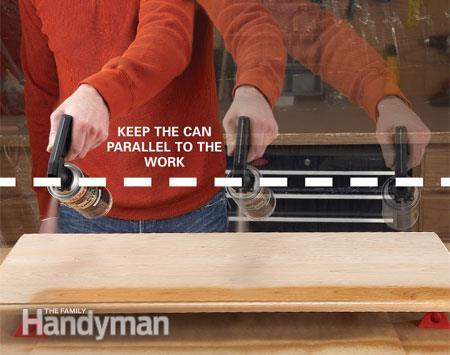
Keep the spray tip parallel to the surface via THE FAMILY HANDYMA?N
Keep the gun an equal distance from the wood at an even pace. This will give you a smooth finish without runs. Applying a few thin coats will also create a smoother finish than having to use thick coats unless you will be using the electric gun.
Sealing Dark Stains
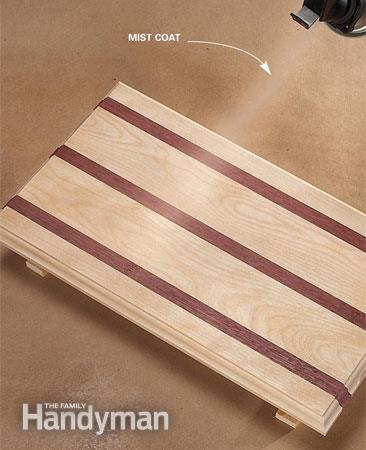
Seal dark stains and exotic wood with a mist coat via THE FAMILY HANDYMAN
If your wood has some dark stains, spraying a heavy coat of them can ruin the overall appearance of your project. The solvent in the finish could also dissolve the stain and cause the wood to bleed.
The solution is to apply a mist coat before the heavy coat and you can achieve this by moving the gun a bit higher and a bit faster. This is to reduce the amount of spray that hits the surface.
HVLP Spraying Polyurethane on Outdoor Projects via DarbinNotes
- Spray Finishing on Wood via THE FAMILY HANDYMAN
- How To Spray Polyurethane Without Making A Mess
Troubleshooting Polyurethane
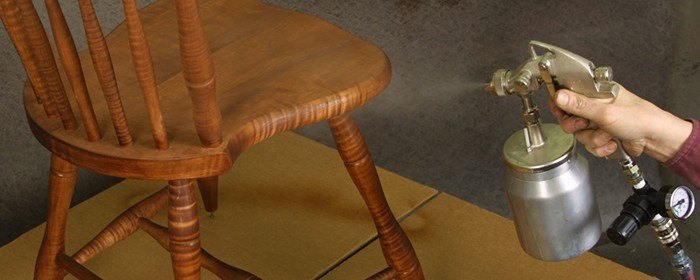
Spraying via Homestead Finishing Products
Things while applying polyurethane can go really wrong, especially if you are not experienced so just in case things go south, here are a few pieces of advice. Polyurethane tends to form bubbles quite a lot and they harden to the surface.
In addition to that, it can also have cracks, runs, checks, separation and blushing. Most of these you can correct by sanding and recoating.?
You should sand bubbles that are hard or checks with a 220-grit sandpaper. Do not try to remove bubbles while the finish is wet because you will cause more damage. Blushing is not very common with polyurethane unless the wood is very wet and the temperatures are high.
It is always best to recoat polyurethane after it dries tack free in about a few hours and before it cures, which can be before 24 to 48 hours.?
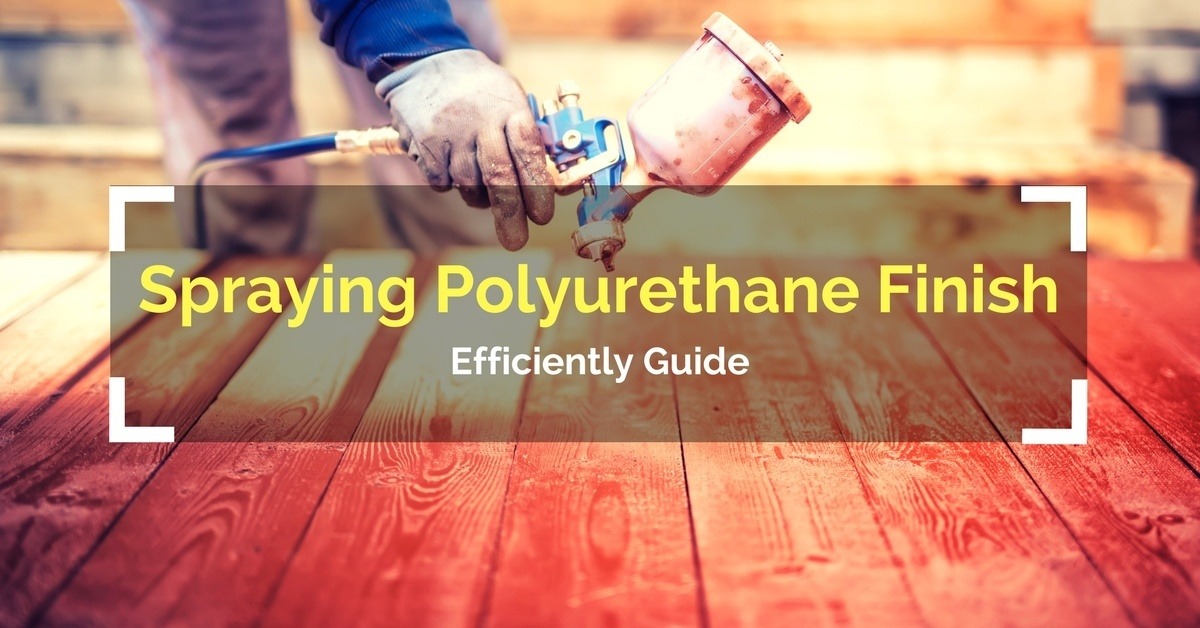
Putting a great Finnish on wood is not complicated as people make it out to be. I spray oil base poly all the time in my garage using a 15 dollar sprayer from harbor freight.
Helmsmen sprays very good with a 2:1 mix. 2 parts poly to one part thinner (mineral
spirts) put the compressor on 90 psi and set the gun to 32 psi when the trigger is open.
sanding should be done after the first couple of coats. dry time is six to 24 hours be it looks 100% better than water base.
I fined brushing on poly not thinned goes on to thick and take a long time to dry. 6 to 8 thin coats will give you a much greater finish than 3 to 4 heavy brushed coats
try it on some scrap if its to heave you can sand it off.